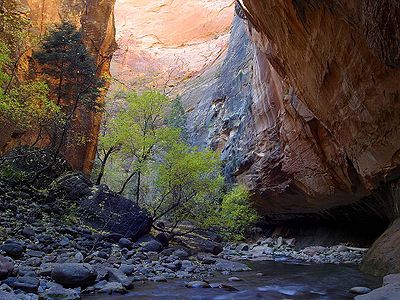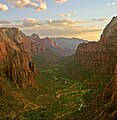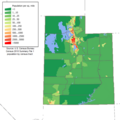The Utah Portal  Utah (/ˈjuːtɑː/ YOO-tah, /ˈjuːtɔː/ YOO-taw) is a landlocked state in the Mountain West subregion of the Western United States. It is one of the Four Corners states, sharing a border with Arizona, Colorado, and New Mexico. It also borders Wyoming to its northeast, Idaho to its north, and Nevada to its west. In comparison to all the U.S. states and territories, Utah, with a population of just over three million, is the 13th largest by area, the 30th most populous, and the 11th least densely populated. Urban development is mostly concentrated in two regions: the Wasatch Front in the north-central part of the state, which includes the state capital, Salt Lake City, and is home to roughly two-thirds of the population; and Washington County in the southwest, which has somewhat more than 180,000 residents. Most of the western half of Utah lies in the Great Basin. Utah has been inhabited for thousands of years by various indigenous groups, such as the ancient Puebloans, the Navajo, and the Ute. The first Europeans to arrive - in the mid-16th century - were the Spanish. Because of the region's challenging geography and harsh climate, it only became a peripheral part of New Spain (and later of Mexico). Even while it was Mexican territory, many of the Utah region’s earliest European settlers were from the United States; notable among these were Mormons who were fleeing marginalization and persecution in the United States and arrived via the so-called Mormon Trail. In 1848, after the Mexican–American War, the region was annexed by the U.S., becoming part of the Utah Territory, which included what later became Colorado and Nevada. Disputes between the dominant Mormon community and the federal government delayed Utah's admission as a state: in 1896, after it agreed to outlaw polygamy, it was admitted as the 45th state. People from Utah are known as Utahns. Slightly over half of all Utahns are Mormons, the vast majority of whom are members of the Church of Jesus Christ of Latter-day Saints (LDS Church), which has its world headquarters in Salt Lake City; Utah is the only state where a majority of the population belongs to a single church. The LDS Church greatly influences Utahn culture, politics, and daily life, though since the 1990s the state has become more religiously diverse as well as secular. (Full article...) Entries here consist of Good and Featured articles, which meet a core set of high editorial standards.
 The exposed geology of the Bryce Canyon area in Utah shows a record of deposition that covers the last part of the Cretaceous Period and the first half of the Cenozoic era in that part of North America. The ancient depositional environment of the region around what is now Bryce Canyon National Park varied from the warm shallow sea (called the Cretaceous Seaway) in which the Dakota Sandstone and the Tropic Shale were deposited to the cool streams and lakes that contributed sediment to the colorful Claron Formation that dominates the park's amphitheaters. Other formations were also formed but were mostly eroded following uplift from the Laramide orogeny which started around 70 million years ago (Mya). This event raised the Rocky Mountains far to the east and caused the retreat of the sea that covered the Bryce Canyon area. After Laramide mountain building came to an end, about 15 mya, a large part of western North America began to be stretched into the nearby Basin and Range topography. The greater Bryce area was uplifted as part of the High Plateaus by the same forces. Uplift of the Colorado Plateaus and the opening of the Gulf of California by 5 mya changed the drainage of the Colorado River and its tributaries, including the Paria River, which is eroding headward between two plateaus adjacent to the park. The uplift caused the formation of vertical joints which were later preferentially eroded to form the free-standing pinnacles called hoodoos, badlands, and monoliths we see today. (Full article...) Selected image -November selected anniversaries
Selected biography -Fawn McKay Brodie (September 15, 1915 – January 10, 1981) was an American biographer and one of the first female professors of history at UCLA, who is best known for Thomas Jefferson: An Intimate History (1974), a work of psychobiography, and No Man Knows My History (1945), an early biography of Joseph Smith, the founder of the Latter Day Saint movement. Raised in Utah in a respected, if impoverished, family who were members of the Church of Jesus Christ of Latter-day Saints (LDS Church), Fawn McKay drifted away from Mormonism during her years of graduate work at the University of Chicago and married Bernard Brodie, an academic who became a national defense expert; they had three children. Although Fawn Brodie eventually became one of the first tenured female professors of history at UCLA, she is best known for her five biographies, four of which incorporate insights from Freudian psychology. (Full article...) Selected article -Ute (/ˈjuːt/) are an Indigenous people of the Great Basin and Colorado Plateau in present-day Utah, western Colorado, and northern New Mexico. Historically, their territory also included parts of Wyoming, eastern Nevada, and Arizona. Their Ute dialect is a Colorado River Numic language, part of the Uto-Aztecan language family (Full article...) Did you know -
Selected panorama - Moab, Utah, from the northern canyon walls that surround it.
TopicsCategoriesGeneral imagesThe following are images from various Utah-related articles on Wikipedia.
State facts
State symbols:
Featured contentArticles:
Lists:
Pictures: Related portals
Lists
Related WikiProjectsNew articlesThis list was generated from these rules. Questions and feedback are always welcome! The search is being run daily with the most recent ~14 days of results. Note: Some articles may not be relevant to this project.
Rules | Match log | Results page (for watching) | Last updated: 2024-11-09 22:21 (UTC) Note: The list display can now be customized by each user. See List display personalization for details.
Things you can doAssociated WikimediaThe following Wikimedia Foundation sister projects provide more on this subject:
Discover Wikipedia using portals |
















































































